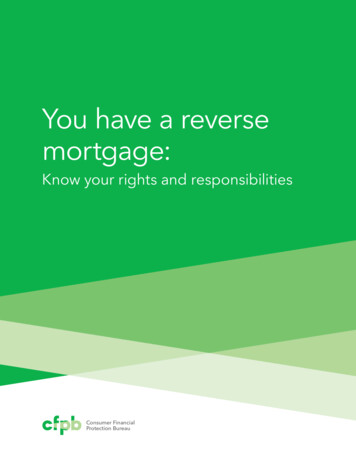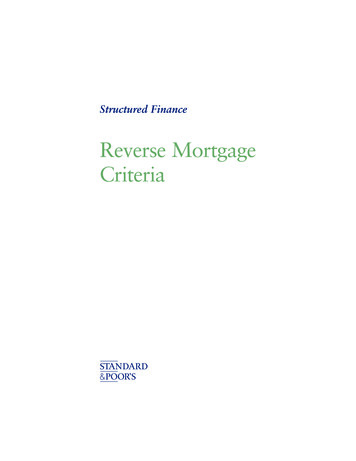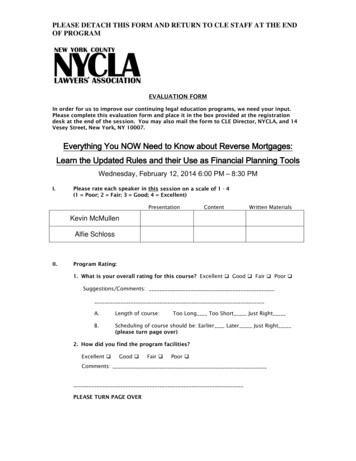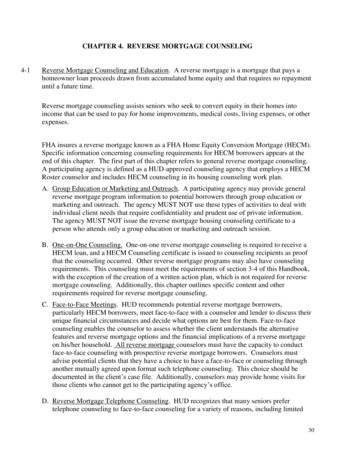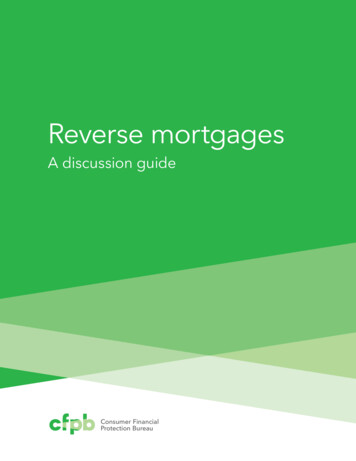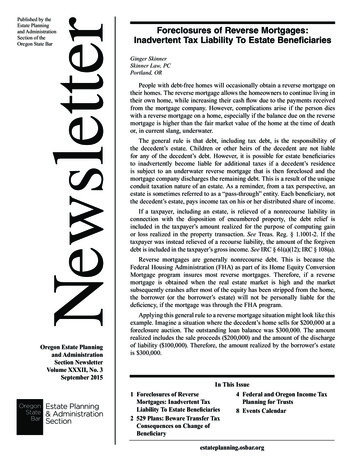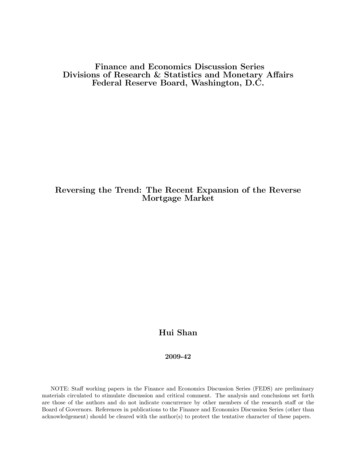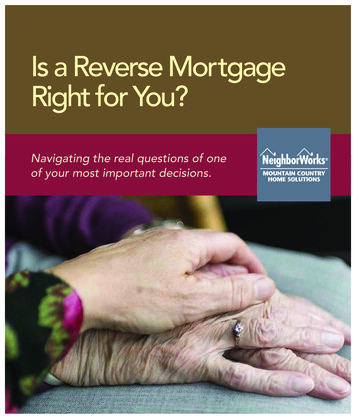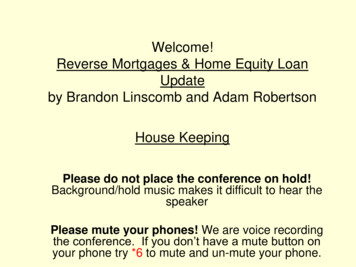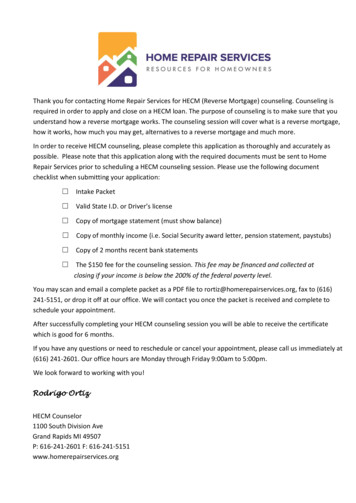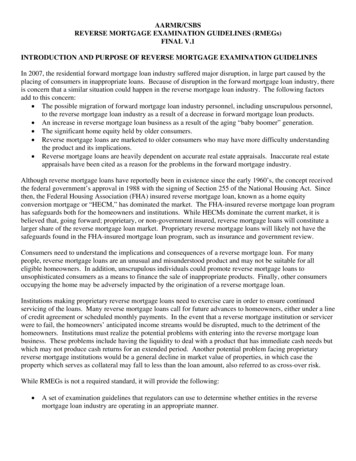
Transcription
AARMR/CSBSREVERSE MORTGAGE EXAMINATION GUIDELINES (RMEGs)FINAL V.1INTRODUCTION AND PURPOSE OF REVERSE MORTGAGE EXAMINATION GUIDELINESIn 2007, the residential forward mortgage loan industry suffered major disruption, in large part caused by theplacing of consumers in inappropriate loans. Because of disruption in the forward mortgage loan industry, thereis concern that a similar situation could happen in the reverse mortgage loan industry. The following factorsadd to this concern: The possible migration of forward mortgage loan industry personnel, including unscrupulous personnel,to the reverse mortgage loan industry as a result of a decrease in forward mortgage loan products. An increase in reverse mortgage loan business as a result of the aging “baby boomer” generation. The significant home equity held by older consumers. Reverse mortgage loans are marketed to older consumers who may have more difficulty understandingthe product and its implications. Reverse mortgage loans are heavily dependent on accurate real estate appraisals. Inaccurate real estateappraisals have been cited as a reason for the problems in the forward mortgage industry.Although reverse mortgage loans have reportedly been in existence since the early 1960’s, the concept receivedthe federal government’s approval in 1988 with the signing of Section 255 of the National Housing Act. Sincethen, the Federal Housing Association (FHA) insured reverse mortgage loan, known as a home equityconversion mortgage or “HECM,” has dominated the market. The FHA-insured reverse mortgage loan programhas safeguards both for the homeowners and institutions. While HECMs dominate the current market, it isbelieved that, going forward; proprietary, or non-government insured, reverse mortgage loans will constitute alarger share of the reverse mortgage loan market. Proprietary reverse mortgage loans will likely not have thesafeguards found in the FHA-insured mortgage loan program, such as insurance and government review.Consumers need to understand the implications and consequences of a reverse mortgage loan. For manypeople, reverse mortgage loans are an unusual and misunderstood product and may not be suitable for alleligible homeowners. In addition, unscrupulous individuals could promote reverse mortgage loans tounsophisticated consumers as a means to finance the sale of inappropriate products. Finally, other consumersoccupying the home may be adversely impacted by the origination of a reverse mortgage loan.Institutions making proprietary reverse mortgage loans need to exercise care in order to ensure continuedservicing of the loans. Many reverse mortgage loans call for future advances to homeowners, either under a lineof credit agreement or scheduled monthly payments. In the event that a reverse mortgage institution or servicerwere to fail, the homeowners’ anticipated income streams would be disrupted, much to the detriment of thehomeowners. Institutions must realize the potential problems with entering into the reverse mortgage loanbusiness. These problems include having the liquidity to deal with a product that has immediate cash needs butwhich may not produce cash returns for an extended period. Another potential problem facing proprietaryreverse mortgage institutions would be a general decline in market value of properties, in which case theproperty which serves as collateral may fall to less than the loan amount, also referred to as cross-over risk.While RMEGs is not a required standard, it will provide the following: A set of examination guidelines that regulators can use to determine whether entities in the reversemortgage loan industry are operating in an appropriate manner.
Uniform standards applicable for multi-state examinations and enforcement actions, or for review byone state of another state’s Report of Examination.Consistent and uniform guidelines for use by institution and broker in-house compliance and auditdepartments.State regulators may wish to use all or portions of RMEGs depending on the size and complexity of theinstitution examined and the available resources of the agency. Examiners should identify within the scope ofthe examination report if and to what extent RMEGs were used so that other state regulators will know that astandard examination model has been employed.RMEGs is divided into major sections or modules. The modules may be used as an entire examination packageor individual modules may be chosen for specific applications. RMEGs Modules include:Module 1 – RMEGs EXAMINER INSTRUCTIONSModule 2 – EXAMINER CHECKLIST TO BE USED FOR ALL INSTITUTIONSModule 3 – EXAMINER CHECKLIST TO BE USED FOR FHA APPROVED ENTITIESModule 4 – REFERENCE AND GLOSSARY OF TERMSModule 5 – INFORMATION AND DATA REQUESTModule 6 – INSTITUTION AND MANAGEMENT QUESTIONNAIREModule 7 – REVERSE MORTGAGE ACTIVITY SUMMARYModule 8 – REVERSE MORTGAGE PRODUCT WORKSHEETModule 9 – REVERSE MORTGAGE SERVICING WORKSHEETDEFINITIONS USED IN RMEGsBroker – An individual or entity which acts as the conduit between a reverse mortgage loan applicant and thereverse mortgage institution. An entity could be considered a broker even if the entity does not take a reversemortgage loan application if the entity steers the applicant to specific brokers or specific institutions. An entitywould be considered a broker if the entity advertises or solicits for reverse mortgage loans and then forwards orprovides interested consumers’ names or identifying information to another broker or institution.Federally insured reverse mortgage loan – A reverse mortgage loan which is insured by, and made underguidelines of, the FHA, a division of the federal Department of Housing and Urban Development. These loansare also referred to as Home Equity Conversion Mortgages or “HECMs”.FHA – Federal Housing AdministrationHECM – Home Equity Conversion Mortgage (see Federally insured reverse mortgage loan).Institution – Any financial institution examined under the RMEGs including brokers and lenders.Loan Originator – The individual who originally takes a reverse mortgage loan application or who has theprimary contact with the reverse mortgage loan applicant.Maturity of a reverse mortgage loan – the event that triggers repayment of the reverse mortgage loan. Examplesof these events may be death or sale of the home.Proprietary Reverse Mortgage Institution – An institution which makes proprietary reverse mortgage loans.
Proprietary Reverse Mortgage Loan – A reverse mortgage loan which is neither a federally insured reversemortgage loan as described above or a single purpose reverse mortgage loan as described below.Reverse Mortgage Loan (Reverse Mortgage) – A loan secured by a lien on residential real estate in which thehomeowner is not required to make payments on the loan until a specific event occurs. Generally, but notexclusively, the event that triggers repayment is when the homeowner ceases to reside in the property.Generally, the loan is due and payable in full at the time of the event occurring. The proceeds of a reversemortgage loan may be disbursed to the homeowner at the time the loan is consummated, over time through aline of credit accessible to the homeowner, over time through regularly scheduled payments, or somecombination of the above methods.Service or Servicing – For the purpose of this document, servicing shall mean any actions taken by aninstitution or an assignee after the consummation of a reverse mortgage loan. Servicing shall include, but not belimited to, making disbursements to the homeowner, paying any escrowed taxes, insurance or other items if socontracted, and collecting the loan payoff or taking possession of the collateral at or after the specific event thattriggers repayment.Single-purpose reverse mortgage loans – Reverse mortgage loans which are made by state or local governmentsor non-profit organizations where the loan proceeds are to be used for a specific purpose.Tenure reverse mortgage loan – a reverse mortgage loan where advances are made to the homeowner for theshorter of either a specified period of time or maturity of the reverse mortgage loan.
MODULE 1 – RMEGs EXAMINER INSTRUCTIONSSCOPINGFull Scope ExaminationA full scope examination would typically consist of off-site preparation and review, followed by an on-siteexamination of records and practices, including interviews of staff and possibly homeowners or third-parties.Follow up to the on-site examination would normally consist of an exit meeting to review initial findings withmanagement, a report of examination and a response by institution management where necessary.A full scope examination of each type of institution should include the following: Mortgage Broker:1. Module 2, Sections A, B (1 through XX), D and G2. Module 3, Sections A, B (1 through XX) and D3. Modules 5, 6, 7 and 8Lender or mortgage bank without retail activity:1. Module 2, all Sections except B (1 through XX)2. Module 3, all Sections except B (1 through XX) – if HECM activity3. Modules 5, 6, 7, 8 and 9 (if servicing)Lender or mortgage bank with retail activity:1. Module 2, all Sections2. Module 3, all Sections – if HECM activity3. Modules 5, 6, 7, 8 and 9 (if servicing)Lender or mortgage bank servicing purchased portfolio only1. Module 2, Sections A, D, E and G2. Module 3, Sections D and E3. Modules 5, 6, 7 and 9Limited Scope ExaminationAn agency may conduct a limited scope examination entirely off-site through review of an institution’sresponse to the RMEGs Modules 5, 6, 7 and 8. While such a review is limited to the veracity of the institution’sresponse, it nevertheless can be a valuable tool for monitoring or in situations where the volume of reversemortgage transaction activity does not merit a full examination of the institution. Examiners should alsoconsider using other state’s RMEGs examination reports in situations where it is impractical to conduct thestate’s own examination.The institution’s complaint activity should be reviewed in conjunction with any limited scope examination.Additionally, a limited scope examination may include portions of any of the sections deemed appropriate. Anylimited scope review should be clearly indicated in the report of examination with a notation that reliability islimited to the institution’s stated responses.General IssuesRegardless of the scope chosen, the examiner should evaluate the institution’s compliance with consumerprotection laws, proper underwriting standards, and risk management practices. At a minimum, the examiner
should evaluate whether the institution has adequate controls for compliance risk, reputation risk, and litigationrisk as well as adequate disclosure of risks to homeowners and when servicing loans, liquidity risk.Note: the examiner should also be aware that written policies and procedures are no substitute for actual soundpractices.
MODULE 2 RMEGs – EXAMINER CHECKLIST TO BE USED FOR ALL INSTITUTIONSThis module is designed to be used for examinations of all types of reverse mortgage institutions, regardless ofproduct originated or funded. Most of the questions in Module 2 will be applicable to all reverse mortgageloans. Certain questions pertain only to Proprietary Reverse Mortgage Loans as defined above. An answer ofNA is acceptable wherever a question does not apply.Module 3 is to be used as an additional checklist for FHA insured reverse mortgages (HECMs); however,Module 3 is to be used in conjunction with Module 2. For examinations of institutions with no FHA insuredreverse mortgage activity the Examiner should skip Module 3 altogether.The RMEGs Examiner Checklist consists of questions intended to prompt the examiner for specific review.Much of the checklist can be completed from a thorough, off-site review of the response to the RMEGsInformation and Data Request (Module 5), the Institution and Management Questionnaire (Module 6), theReverse Mortgage Activity Summary (Module 7), the Reverse Mortgage Product Worksheet (Module 8) andthe Reverse Mortgage Servicing Worksheet (Module 9). Other sections will require file-level review andpossibly interviews of institution staff, homeowners and third parties including appraisers and counselors.A.1A.2A.3A.4A.5A. PRE-EXAMINATIONGENERALExaminer note: This section should be completed regardlessof the scope of the examination or size or type of theinstitution. The questions in this section are general triggersintended to stimulate broad consideration by the examiner.For full scope examinations the examiner should review eachloan file identified from A.2 below.Does management have a clear understanding of itsresponsibilities for Reverse Mortgages? What evidence is therethat management clearly understands the risks associated withReverse Mortgages? Examiner note: Consider response toquestionnaire, policies, procedures and underwritingguidelines, interviews of management and staff, and the actuallending practices of this institution.Have any complaints been filed with the agency against theinstitution relevant to Reverse Mortgages? Examiner note:Review complaints against responses to the Information andData Request and Institution Questionnaire.Has the institution previously been reviewed as part of theexamination of a federal regulator?Examiner note: Obtain a copy of the exam report if possibleand discuss the findings with the federal regulator wherenecessary.Has the institution been examined by any other state?Examiner note: Obtain a copy of the exam report if possibleand discuss the findings with the state regulator whereappropriate.If required, has your agency granted written approval of theinstitution’s reverse mortgage program?YNNAExaminer Notes[Document supportingevidence and notedeterminations andfindings made.]
A.7lA.7mA.7nA.7oA.7pA.7qA.7rA.7sA.7tA.7uA.7vA.8If yes, is the institution adhering to the program as it wasapproved by your agency?Have you (the examiner) obtained and reviewed the RiskBased Survey and a Reverse Mortgage Product Worksheet foreach product originated by the institution?OVERVIEW OF POLICIES AND PROCEDURESExaminer note: Obtain and thoroughly review all policies andprocedures related to Reverse Mortgages.Do written policies and procedures adequately cover (asapplicable): Marketing and consumer contact as well as direct andindirect (third party) origination of Reverse Mortgages? If applicable, counseling requirements? Lending limits? Underwriting and approval processes? Monitoring and reporting? Loan servicing? Secondary market activity? Internal control procedures? Financial accounting? Training? Homeowner’s responsibilities? Compensation to employees? Compensation to outside loan originators? Payoff by homeowner or homeowner’s heirs? Acquisition and dispensation of property when loan isnot paid off? Processing and resolution of consumer complaints? Homeowner age restrictions? Fraud concerns? Homeowner defaults, including situations where thehomeowner has allowed the property to deteriorate, nolonger lives in the property or has failed to pay taxesand insurance? Referrals, including loan referrals, counselor referrals,product referrals and services referrals? Home possessions? Institution default?Examiner note: What policies and procedures exist to assurethat institution is able to continue funding loan commitments?Does institution have a disproportionate or high level ofReverse Mortgages originated as an exception to existingpolicies and procedures?B. CONSUMER CONTACT/ORIGINATIONMARKETING/PROMOTIONAL MATERIALSYNNAExaminer Notes[Document supporting
evidence and notedeterminations andfindings .9cB.9dSince the previous examination, has the institution advertisedreverse mortgage products as a product offering? If yes, describe advertising methods (website, print ads,statement inserts, etc.). If no, is the institution contemplating advertisingreverse mortgages in the future?Do promotional materials and other product descriptionsprovide clear and balanced information about the relative risksof these products?Do promotional materials and other product descriptions,including oral statements or scripts, provide information aboutthe costs, terms, features, and risks of Reverse Mortgages thatcan assist consumers in their product selection decisions?Are product descriptions provided when the consumer makesan inquiry to the institution about a mortgage product andreceives information about Reverse Mortgages, or whenmarketing relating to Reverse Mortgages is provided by theinstitution to the consumer, rather than just upon thesubmission of an application or at consummation?Does the institution use any form of solicitation that appears tobe generated by the Government, or related to the Government(formal looking codes, emblems such as eagles, etc.)?Does the institution use any form of solicitation that can beinterpreted as misleading to the consumer, such as referencesto affiliations with organizations or financial institutions thatare not true?DIRECT ORIGINATION (for providers that deal directlywith consumers)Product SelectionDoes the institution market or originate non-governmentinsured (e.g. proprietary products) Reverse Mortgages? [SeeReverse Mortgage Product Worksheet from question A.6.]Are adequate criteria used to determine whether a consumer isreferred to one of the institution’s proprietary reversemortgages or to one of the government insured products?Examiner note: Specific consideration for FHA insured loansis covered in Module 3.Does the institution provide consumers with adequatecomparisons for the purposes of selecting products, including: FHA insurance or other guarantees? The existence or lack of escrow accounts? Payment disbursement method (e.g. lump sum, line ofcredit, monthly, etc.)? Other (e.g. termination clauses or other important
2bcontractual terms in notes or riders)?Counseling (if required for non-HECM loans)Examiner note: For HECM loans use counseling section inModule 3.Does the institution maintain a current listing of Stateapproved reverse mortgage counselors/counseling programs?If the state has specific requirements for the referral ofhomeowners to counselors, has the institution complied withthose requirements?Counselor certification/verification: Are certifications required? Does the institution verify that the counselor iscertified? Are certifications maintained?Is counseling sufficient when conducted: In person? By telephone? Other? (Explain)Is the length of counseling sufficient to adequatelycommunicate information to the homeowner and answer allhomeowner questions and concerns?Are there any charges to the homeowner prior to counseling?If yes, explain.If counseling is other than with homeowner(s), does theinstitution obtain appropriate legal documents supportingpower of attorney, court-appointed conservator/guardian, etc.?Does the institution ever pay for counseling services?Does the institution receive any reimbursement for counselingfees?If the institution pays for counseling services are suchpayments deemed bona fide, reasonable, and appropriate?Does the institution take prudent steps if they have concerns orcomplaints about the services provided by a particularcounselor (e.g. contact appropriate counselor supervisoryagency)?Other State Specific Counseling Requirements[Use this section to include state specific requirements]Application DisclosuresIn relation to the Real Estate Settlement Procedures Act(RESPA) and Regulation X: Was the appropriate good faith estimate provided forclosed-end credit?Examiner note: See Regulation X, Section 3500.7(a) forInstitutions or (b) for Brokers. Was the appropriate disclosure provided for open-endcredit?
5aB.25bB.26B.27B.27aB.27bB.27cExaminer note: See Regulation X, Section 3500.7(f) – ifdisclosures required by 12 C.F.R. 226.5b of Reg Z areprovided at the time of application, this section shall bedeemed to be satisfied.)Was the Servicing Disclosure Statement provided?Examiner note: See Regulation X, Section 3500.21(b).In relation to the Truth In Lending Act (TILA) and RegulationZ: Was the appropriate TIL disclosure provided forclosed-end credit?Examiner note: See all of Regulation Z, Subpart C. Was the appropriate TIL disclosure provided for openend credit?Examiner note: See Regulation Z, Sections 226.5b, 226.6, 226.14 and 226 .16. Was the initial Total Annual Loan Cost disclosureprovided?Examiner note: See Regulation Z, Section 226.33 covering theRequirements for Reverse Mortgages. The Total Annual LoanCost disclosure or TALC should include the requirementsunder Section 226.33 and incorporate the equations underRegulation Z, Appendix K for computing the TALC. Was the Comparison & Ammortiztion Scheduleprovide?In relation to the Equal Credit Opportunity Act (ECOA) andRegulation B: Was the Appraisal Notice provided?Examiner note: See Regulation B, Section 202.14. Was an adverse action notification needed and given?Examiner note: See Regulation B, Section 202.9.State Specific Application Disclosures[Use this section to include state specific requirements]Closing DisclosuresWas the HUD Settlement Statement provided?Examiner note: See Regulation X, Section 3500.8.In relation to the Truth In Lending Act (TILA) and RegulationZ: Was the appropriate closing or final TIL provided forclosed-end credit?Examiner note: See all of Regulation Z, Subpart C. Was the appropriate closing or final TIL provided foropen-end credit?Examiner note: See Regulation Z, Sections 226.5b and 226.14. Was the closing TALC provided?Examiner note: See Regulation Z, Section 226.33 covering the
0cB.30dB.30eB.30fRequirements for Reverse Mortgages. The Total Annual LoanCost disclosure or TALC should include the requirementsunder Section 226.33 and incorporate the equations underRegulation Z, Appendix K for computing the TALC. Was the Comparison & Ammortiztion Scheduleprovide? Was the appropriate right of rescission notice providedfor other than a purchase loan on closed-end credit?Examiner note: See Regulation Z, Section 226.23. Was the appropriate right of rescission notice providedfor other than a purchase loan on open-end credit?Examiner note: See Regulation Z, Section 226.15.Were both the Note and Mortgage provided?Examiner note: Providing the note and mortgage is requiredfor HECM lending. For non-HECM products reference statelaw or regulation, if any. Providing the note and mortgage onall reverse mortgage loans is considered a CSBS/AARMRrecommended best practice.State Specific Closing Disclosures[Use this section to include state specific requirements]INDIRECT ORIGINATION (for institutions funding loansthrough brokers or other institutions)Are the institution’s standards for using third-party originatorsfor Reverse Mortgages adequate? Examiner note: Inconsideration of this question the examiner should determinethe following: Does the institution conduct appropriate due diligenceof third-party originators including pre-relationship review,transaction underwriting review and post-closing reviews? Does the institution have adequate criteria for enteringinto and maintaining relationships with third-party originatorsto originate Reverse Mortgages?Examiner note: Consider whether the institution monitorsthird party originators for the elements identified underMarketing and Direct Origination above. Has the institution established appropriate criteria forthird-party compensation and incentives? Does the institution regularly review a reasonablesample of Reverse Mortgages to determine compliance withestablished policies, procedures and prudent management ofthe institution in a safe and sound manner? Does the institution monitor third parties for marketing,sales practices, appraisal problems, loan documentation, andconsumer complaints? Does the institution inquire as to the type of businessactivity the third-party performs other than reverse mortgages
B.31B.32B.32aB.32bB.32cB.32dB.33B.34(e.g., forward mortgages, insurance sales, securities, etc.)?Are third party originators paid a different rate based on theproduct they sell? If so, discuss the compensation scheduleand the examiner’s opinion of the compensation schedule.Are compensated services in compliance with anti-kick backprovisions under Regulation X to RESPA? Examiner note: SeeRegulation X, § 3500.14 and 3500. 15. For purposes ofidentifying compensable services under RESPA, HUD RESPAStatements of Policy 1999-1 and 2001-1 (66 Federal Register53052, at 53055, October 18, 2001) provide further guidance.In consideration of this question the examiner should ask: Is there any indication or evidence that the fees paid tothird-parties amount to “referral fees”? Are the third-party services “meaningful” (e.g. not forsteering purposes)? Do payments bear a reasonable relationship to themarket value of the services provided? Does the final HUD-1 Settlement Statement contain theamount paid and name of the mortgage broker or thirdparty?When deficiencies are noted with third-party originators doesthe institution take appropriate immediate action?Examiner note: Remedial action may include more thoroughapplication reviews, more frequent re-underwriting, ortermination of the third-party relationship.SUMMARY: Are strong risk management standards presentwhen using third-party originators for Reverse Mortgages?C. UNDERWRITINGHOMEOWNER QUALIFICATIONSC.1C.2C.3C.4C.5Safety and Soundness – Non-HECM LoansDoes the institution have underwriting policies based onhomeowners’ ages and equity in the property?If required by law, have all homeowners obtained adequatecounseling?Examiner note: CSBS/AARMR considers counseling on allloans to be a best practice. The examiner should considermaking such recommendation to the institution.Has the institution completed a title search to identify anyexisting liens?Have any existing liens been paid off through the loan,subordinated, or adequately taken into account whendetermining the loan amount?Is an appraisal obtained, reviewed and retained?YNNAExaminer Notes[Document supportingevidence and notedeterminations andfindings made.]
17C.18Have all loan amounts been determined in accordance with theinstitution’s underwriting policies?Is there insurance attached to the product?Examiner note: See following questions. CSBS/AARMRconsider insurance protecting both the institution and thehomeowner to be a best practice. The examiner shouldconsider making such recommendation to the institution. Insurance protecting the institution in case of equitydeficiency? Insurance protecting the homeowner in case ofinstitution failure?Homeowner ProtectionExaminer note: The following sections are not necessarilyviolations of law. The examiner should consider advisingmanagement on specific areas of homeowner protection andthe prudence of inclusion of homeowner protections in policyand procedure.Have all homeowners received outside counseling regardingthe consequences of a reverse mortgage?Does the institution urge the homeowner to discuss the reversemortgage transaction with any family members or otherinterested parties?Does the institution inquire about any non-homeownersresiding in the property and if provisions have been made forthem upon the death or relocation of the homeowners?Does the institution fully consider monthly amounts for taxes,insurance and other items when determining the homeowner’scash flow needs and suitability of the loan?If homeowners are responsible for payment of their taxes andinsurance is there documentation that this has been explainedto the homeowners?If a reverse mortgage is a tenure reverse mortgage loan, i.e., aloan where disbursements will only be made for a fixed periodof time, has the homeowner been asked about his/her conditionafter the payments end?Has the institution inquired as to the use of cash outdisbursements to determine that the proceeds are not beingused for questionable or inappropriate purposes, e.g., for thepurchase of a long term investment?Has the institution avoided taking any collateral other than thehomeowner’s residence?Does the institution make any notes regarding a homeowner’smental capacity and take appropriate action if the homeownersappear confused or unable to understand any discussions?When dealing with persons holding power of attorney for ahomeowner, does the institution verify the power of attorney?Has the institution avoided offering, brokering or making areverse mortgage loan that the institution knows or has reason
.19dC.20C.21to know is unsuitable or inappropriate for any of the followingreasons? The homeowner does not intend to reside in theproperty on a long term basis. Against the homeowner’s wishes, non-homeownerresidents of the property would be displaced at thematurity of the loan because they will not be able topay off the reverse mortgage loan. The homeowner will use the proceeds of the reversemortgage loan to purchase a product, generally but notexclusively annuities or investments, which are notappropriate for the homeowner. The homeowner does not understand the ramificationsof a reverse mortgage loan. The amount of money which the homeowner canobtain from a reverse mortgage loan is insufficient tomeet the homeowner’s needs or is not enough to justifythe initial cost of a reverse mortgage loan. There are alternative measures which the homeownercan use which are more suited to the homeowner’sfinancial needs.Was another home owner removed from title prior to or duringunderwriting? Was the removed home owner under the age of 62? Was the removed home owner significantly younger
Reverse Mortgage Loan (Reverse Mortgage) - A loan secured by a lien on residential real estate in which the homeowner is not required to make payments on the loan until a specific event occurs. Generally, but not exclusively, the event that triggers repayment is when the homeowner ceases to reside in the property.
